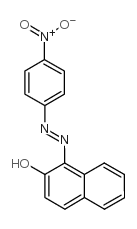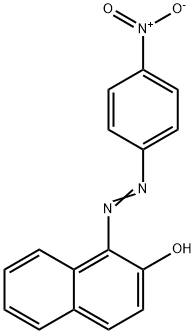对位红,标准溶液,溶剂:乙腈, 1000μg/mL
产品编号:西域质检-TM14264| CAS NO:6410-10-2| 分子式:C16H11N3O3| 分子量:293.27700
本网站销售的所有产品仅用于工业应用或者科学研究等非医疗目的,不可用于人类或动物的临床诊断或者治疗,非药用,非食用,
对位红
本标准物质主要用于测量仪器校准,分析方法评价和质量控制,以及食品,卫生,环境和农业等领域相应成分含量测定与残留检测,也可用于量值溯源或作为标准储备溶液,通过逐级稀释配制成各种工作用标准溶液等。
本标准物质采用纯度准确定值的对位红纯品为原料,以HPLC级乙腈为溶剂,采用重量法准确配制而成。
对位红,英文名称:Para Red ,CAS No. : 6410-10-2
本标准物质以配制值作为标准值,采用高效液相色谱法-二极管阵列检测器(HPLC-DAD)对本批次标准物质和质量控制对照样品进行比对,核验配制值。通过使用满足计量学特性要求的制备方法,测量方法和计量器具,保证标准物质的量值溯源性。
标准值:1000μg/mL,扩展不确定度(K=2):2%
标准值的不确定度主要由原料纯度,称量,定容以及均匀性,稳定性等不确定度分量合成。
依据JJF1343-2012[标准物质定值的通用原则及统计学原理],对分装后的样品进行随机抽样,对溶液浓度进行均匀性检验,稳定性考察。结果表明,本标准物质均匀性,稳定性良好。
本标准物质量值自定值日期起,有效期18个月, 研制单位将继续跟踪监测该标准物质的稳定性,有效期内如发现量值变化,将及时通知用户。
1.包装: 本标准物质采用硼硅酸盐玻璃安瓿瓶包装,约1.2mL/支 ,移取或稀释时请以移液管量取为准。
2.运输和贮存: 常温运输,运输时应避免挤压,碰撞;常温(20±5)℃,置于阴凉处贮存。
3.使用: 启封前于室温(20±3)℃平衡,并充分摇匀。安瓿瓶一经打开,应立即使用,不可再次熔封后作为标准物质使用。
相关文档
化学品安全说明书(MSDS)
下载MSDS质检证书(COA)
相关产品
| 符号 |

GHS07 |
|---|---|
| 信号词 | Warning |
| 危害声明 | H315-H319-H335 |
| 警示性声明 | P261-P305 + P351 + P338 |
| 个人防护装备 | dust mask type N95 (US);Eyeshields;Gloves |
| 危害码 (欧洲) | Xi |
| 风险声明 (欧洲) | 36/37/38 |
| 安全声明 (欧洲) | S24/25-S36-S26 |
| 危险品运输编码 | NONH for all modes of transport |
| RTECS号 | QL4510000 |
| 海关编码 | 2927000090 |
Synonym:1-(4-Nitrophenylazo)-2-naphthol; 1-((4-Nitrophenyl)azo)-2-naphthol; 1-(p-Nitrophenylazo)-2-naphthol; 2-Naphthalenol, 1-((4-nitrophenyl)azo)-; 2-Naphthol, 1-((4-nitrophenyl)azo) Section 2 - COMPOSITION, INFORMATION ON INGREDIENTS
Risk Phrases: None Listed. Section 3 - HAZARDS IDENTIFICATION EMERGENCY OVERVIEW
Not available. Potential Health Effects Eye: Causes eye irritation. May cause chemical conjunctivitis. Skin: Causes skin irritation. Ingestion: May cause gastrointestinal irritation with nausea, vomiting and diarrhea. Inhalation: Causes respiratory tract irritation. Can produce delayed pulmonary edema. Chronic: Effects may be delayed. Section 4 - FIRST AID MEASURES Eyes: Immediately flush eyes with plenty of water for at least 15 minutes, occasionally lifting the upper and lower eyelids. Get medical aid. Skin: Get medical aid. Flush skin with plenty of water for at least 15 minutes while removing contaminated clothing and shoes. Wash clothing before reuse. Ingestion: Never give anything by mouth to an unconscious person. Get medical aid. Do NOT induce vomiting. If conscious and alert, rinse mouth and drink 2-4 cupfuls of milk or water. Inhalation: Remove from exposure and move to fresh air immediately. If not breathing, give artificial respiration. If breathing is difficult, give oxygen. Get medical aid. Do NOT use mouth-to-mouth resuscitation. Notes to Physician: Treat symptomatically and supportively. Section 5 - FIRE FIGHTING MEASURES General Information: As in any fire, wear a self-contained breathing apparatus in pressure-demand, MSHA/NIOSH (approved or equivalent), and full protective gear. During a fire, irritating and highly toxic gases may be generated by thermal decomposition or combustion. Extinguishing Media: Use water spray, dry chemical, carbon dioxide, or appropriate foam. Section 6 - ACCIDENTAL RELEASE MEASURES General Information: Use proper personal protective equipment as indicated in Section 8. Spills/Leaks: Sweep up, then place into a suitable container for disposal. Avoid generating dusty conditions. Provide ventilation. Section 7 - HANDLING and STORAGE Handling: Wash thoroughly after handling. Remove contaminated clothing and wash before reuse. Minimize dust generation and accumulation. Avoid contact with eyes, skin, and clothing. Avoid ingestion and inhalation. Use with adequate ventilation. Storage: Store in a tightly closed container. Store in a cool, dry, well-ventilated area away from incompatible substances. Section 8 - EXPOSURE CONTROLS, PERSONAL PROTECTION Engineering Controls: Facilities storing or utilizing this material should be equipped with an eyewash facility and a safety shower. Use adequate ventilation to keep airborne concentrations low. Exposure Limits CAS# 6410-10-2: Personal Protective Equipment Eyes: Wear appropriate protective eyeglasses or chemical safety goggles as described by OSHA's eye and face protection regulations in 29 CFR 1910.133 or European Standard EN166. Skin: Wear appropriate protective gloves to prevent skin exposure. Clothing: Wear appropriate protective clothing to prevent skin exposure. Respirators: A respiratory protection program that meets OSHA's 29 CFR 1910.134 and ANSI Z88.2 requirements or European Standard EN 149 must be followed whenever workplace conditions warrant respirator use. Section 9 - PHYSICAL AND CHEMICAL PROPERTIES Physical State: Powder Color: red Odor: None reported. pH: Not available. Vapor Pressure: Not available. Viscosity: Not available. Boiling Point: Not available. Freezing/Melting Point: 248.00 - 252.00 deg C Autoignition Temperature: Not applicable. Flash Point: Not applicable. Explosion Limits, lower: Not available. Explosion Limits, upper: Not available. Decomposition Temperature: Not available. Solubility in water: Not available. Specific Gravity/Density: Not available. Molecular Formula: C16H11N3O3 Molecular Weight: 293.27 Section 10 - STABILITY AND REACTIVITY Chemical Stability: Stable at room temperature in closed containers under normal storage and handling conditions. Conditions to Avoid: Incompatible materials, dust generation, excess heat, strong oxidants. Incompatibilities with Other Materials: Strong oxidizing agents. Hazardous Decomposition Products: Nitrogen oxides, carbon monoxide, irritating and toxic fumes and gases, carbon dioxide, nitrogen. Hazardous Polymerization: Has not been reported. Section 11 - TOXICOLOGICAL INFORMATION RTECS#: CAS# 6410-10-2: QL4510000 LD50/LC50: Not available. Carcinogenicity: Para Red - Not listed by ACGIH, IARC, or NTP. Other: See actual entry in RTECS for complete information. Section 12 - ECOLOGICAL INFORMATION Section 13 - DISPOSAL CONSIDERATIONS Dispose of in a manner consistent with federal, state, and local regulations. Section 14 - TRANSPORT INFORMATION IATA Not regulated as a hazardous material. IMO Not regulated as a hazardous material. RID/ADR Not regulated as a hazardous material. Section 15 - REGULATORY INFORMATION European/International Regulations European Labeling in Accordance with EC Directives Hazard Symbols: Not available. Risk Phrases: Safety Phrases: S 24/25 Avoid contact with skin and eyes. WGK (Water Danger/Protection) CAS# 6410-10-2: No information available. Canada CAS# 6410-10-2 is listed on Canada's NDSL List. CAS# 6410-10-2 is not listed on Canada's Ingredient Disclosure List. US FEDERAL TSCA CAS# 6410-10-2 is listed on the TSCA inventory. SECTION 16 - ADDITIONAL INFORMATION N/A |









 浙公网安备 33010802013016号
浙公网安备 33010802013016号